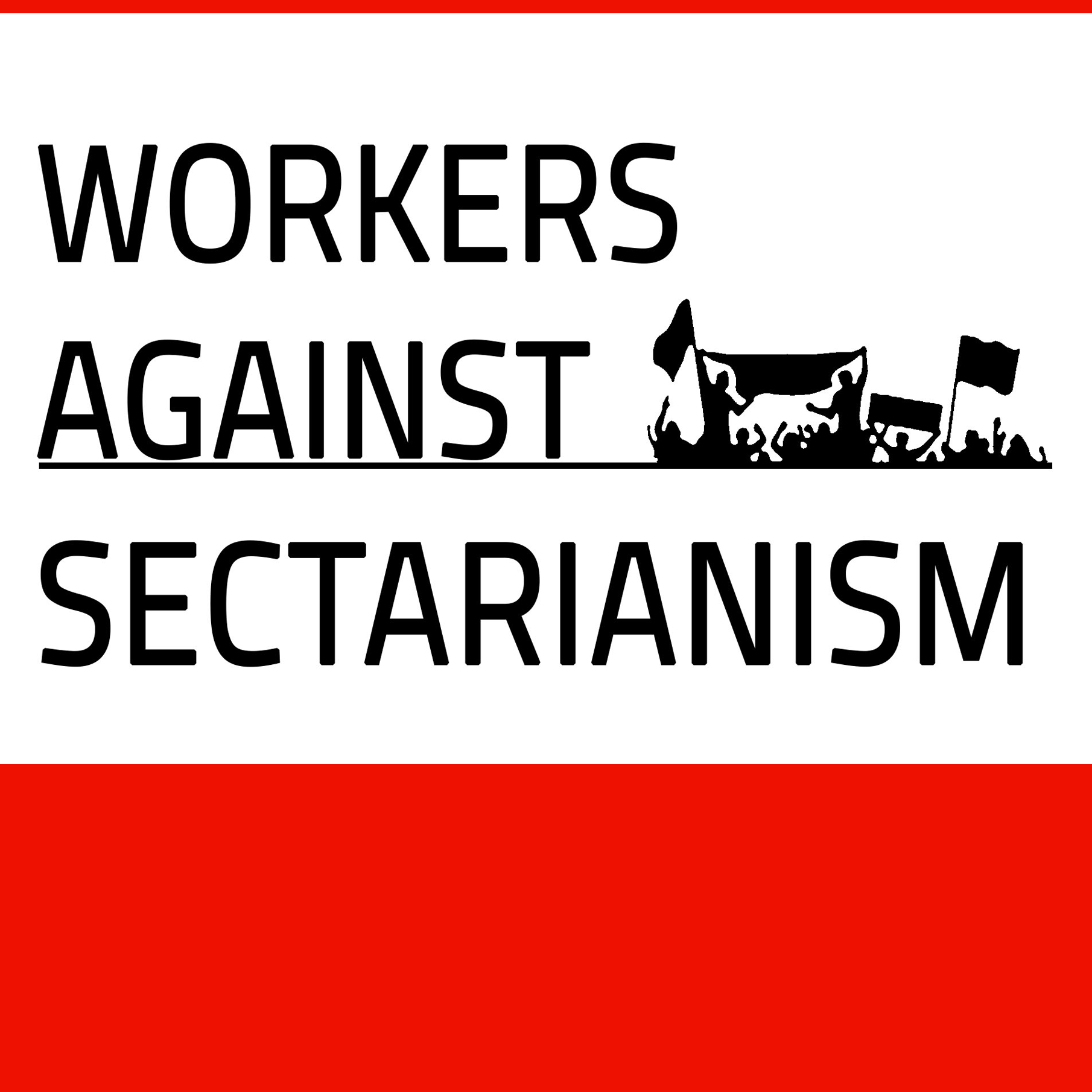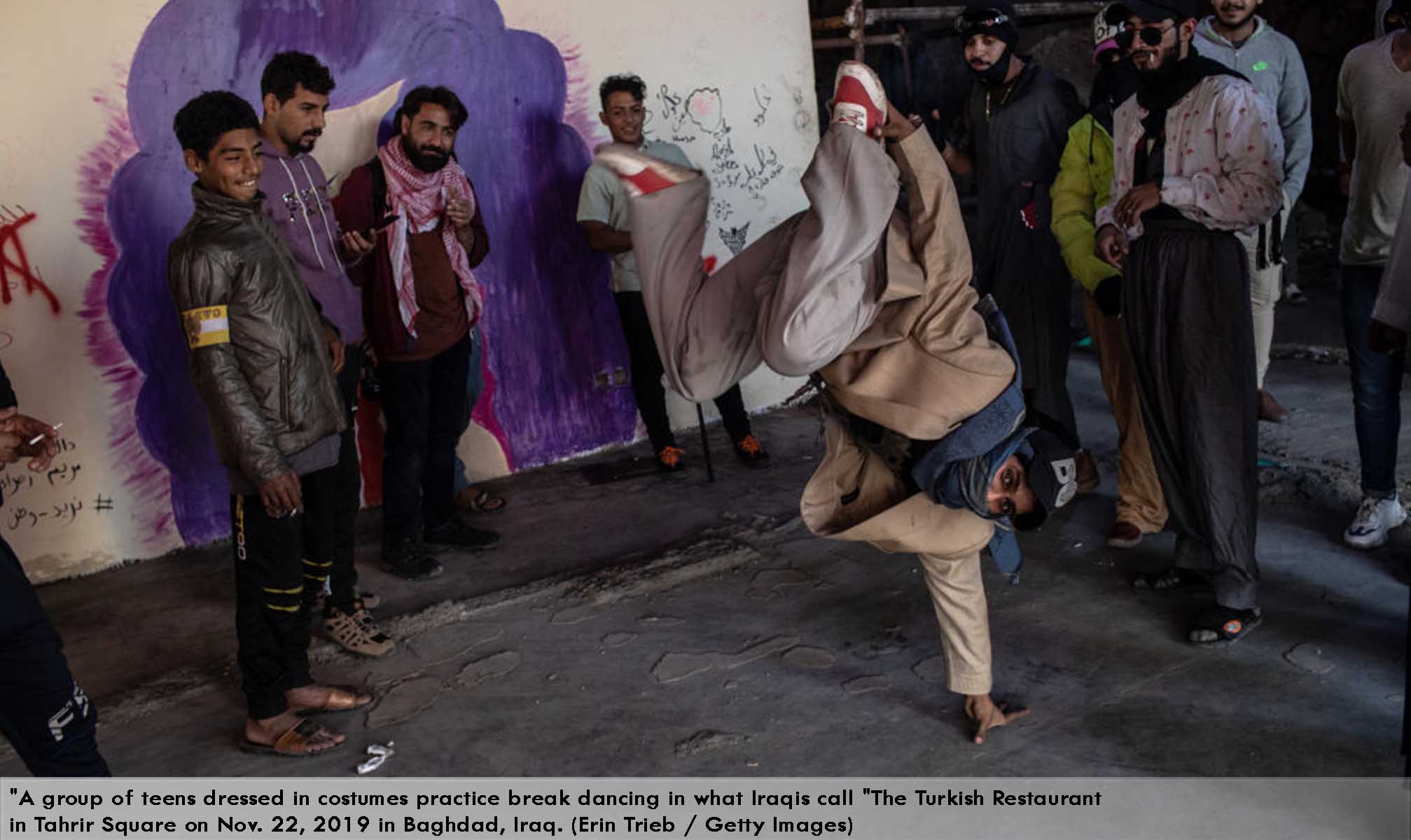BY SCHLUWA SAMA
Protesters in Iraq are rejecting the imprints of war and sectarianism that have destroyed the country — and attempting to build an egalitarian homeland that will put ordinary Iraqis first.
In Iraq, “we need a homeland” is the most popular and persistent demand by protesters. It is not only chanted in slogans but also represented in people’s practices in the occupied squares, the most prominent of which is Baghdad’s Tahrir Square. What might sound like a purely nationalist sentiment is nothing less than a call by Iraq’s unemployed, impoverished youth — supported by the middle classes — to take ownership over all facets of life from the ruling class and strip away the imprints of war and sectarianism that have destroyed the country.
In the demonstrations, which originally erupted in October, young men and women are protesting together, shouting, “Here are your men, oh homeland” and “Here are your women, oh homeland” — a response to the recent entreaties by Muqtada al-Sadr, the influential cleric, that protesters of mixed genders not mingle, that they refrain from smoking, and that all women wear headscarves. These defiant displays are a way of embodying a new type of homeland, radically breaking with the vision of leaders like al-Sadr, who has proclaimed that Iraq is and shall stay “a conservative society.”
If anything, al-Sadr’s attack on the protests has only strengthened them. On January 26, thousands of students joined the uprising, denouncing Iranian and US influence in the country. The massive turnout showed not only the movement’s readiness to defy any representative of “the old homeland” (i.e. the ruling elite), it also revealed splits within al-Sadr’s largely poor constituency, with some growing disillusioned with the cleric’s rhetoric and joining the call for a homeland devoid of sectarianism.
When Iraqis draw graffiti with the cuneiform script of the ancient Sumerian civilization in Tahrir Square, they are actively remaking their own history and denouncing the sectarianism that has divided the nation for the ruling class’s benefit. When they put up posters speaking in the name “of the people” and ban any sectarian language, they are expressing their desire to put ordinary Iraqis of all stripes first.
The country’s sectarianism is an outgrowth of the 2003 US invasion, whose exponents viewed Iraq as irrevocably divided between Sunni, Shi’a, and Kurds and institutionalized a sectarian system. The arrangement fueled an insurgency, sectarian violence, and the rise of ISIS — all while a corrupt, Iraqi-exiled elite, in close affiliation with the US, exploited Iraq’s resources. At the height of the sectarian war between 2006 and 2008, fifty-two thousand people lost their lives and Iran moved in, seeing opportunities to gain political and economic might within Iraq. In 2017, the war against ISIS took the lives of an estimated nine thousand to eleven thousand civilians, all while militarizing society and strengthening the militias that people are now struggling against.
Those who bore the brunt of the violence were impoverished young men, who found both a source of income and a sense of belonging in the militias. Many of them were propelled by a sectarian ideology. Now, they demand a homeland and a secular state that would allow for an all-inclusive Iraqi identity and a more just distribution of the country’s wealth. In contrast, the leaders of the militias, including al-Sadr, are today part of Iraq’s ruling class, firmly established within the government and distributing the country’s wealth according to sectarian and party loyalties (the so-called muhasasa ta’ifia, or sectarian apportionment system).
If those who drive the protests are calling for a homeland, it is not only to break with sectarianism, but to resist the ruling class’s oil deals with multinational companies. Large portions of the revenue from these pacts, which make up almost all of the state’s income, remain in the pockets of the ruling elite. The ruling class, protesters charge, is stealing from the lower and middle classes while opening up the country to products that have decimated the local economy.
This destruction of Iraq’s economy, especially agriculture, has a longer history. Until 2003, Iraq boasted a rich array of indigenous seed varieties. But the US was more concerned with safeguarding the intellectual property rights of US companies than the thousand-year history of Iraqi seeds. Order 81 — issued by Paul Bremer, head of the Coalition Provision Authority, in 2004 — banned indigenous seeds and promoted the genetically modified seeds of Monsanto. Iraqi farmers and peasants were left with little option but to rebuy seeds (and chemicals) every year, instead of (re)using indigenous varieties.
Iraq’s fraught relationship with the global economy dates back to the Saddam Hussein years. In the 1980s, the dictator used booming oil exports to cover food imports of 1.4 billion US dollars and finance a devastating eight-year war with Iran. The brutality continued the following decade. In 1991, Hussein suppressed a major uprising in the Kurdish north and the south. The First Gulf War ended with harsh United Nations sanctions driven by the US government — an invisible war that took the lives of more than half a million children under the age of five.
With the introduction of the oil-for food program during the sanctions period, Iraqi lives were again tied to the global oil market. Oil was exported and, in return, food was distributed to Iraqi citizens. Lissy Schmidt, a journalist in Iraqi Kurdistan, observed the endless convoys of aid entering Iraq in 1992, explaining: “Products are bought in Turkey worth 90 Million dollars from the US money allocations to the UN.” Farmers still recall how suddenly sacks of rice were distributed, making their own agricultural work superfluous.
Read more from the source: Jacobin mag

 Nominating a new parliament speaker without any immediate solutions since last year, 2023.
Nominating a new parliament speaker without any immediate solutions since last year, 2023. On the memory of the genocide that the marshes were subjected to, who are the Ahwarians?
On the memory of the genocide that the marshes were subjected to, who are the Ahwarians? Muqtada al-Sadr’s militia attack the Green Zone in Baghdad
Muqtada al-Sadr’s militia attack the Green Zone in Baghdad The environmental activist Jassim al-Asadi, who seeks to protect the marshes in Iraq, has been kidnapped on 1/2/2023.wed
The environmental activist Jassim al-Asadi, who seeks to protect the marshes in Iraq, has been kidnapped on 1/2/2023.wed Working women in Iraq – the way to work is not safe
Working women in Iraq – the way to work is not safe Urgent: Total chaos inside Iraq, imposing a curfew, general closure of all government institutions, in addition to leaving most of the embassies of foreign countries in Baghdad.
Urgent: Total chaos inside Iraq, imposing a curfew, general closure of all government institutions, in addition to leaving most of the embassies of foreign countries in Baghdad.














